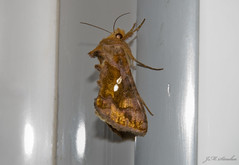
Zoropsis spinimana (Dufour, 1820), a photo by Macrodomo on Flickr.
Pentax K20D - 1/180 - f/11.0 - 200 mm - ISO400 - Flash: On, Fired.
Reino: Animalia
Phylum: Artrópodos
Clase: Arachnida
Orden: Araneae
Suborden: Araneomorphae
Familia: Zoropsidae
Género: Zoropsis
Especies: Z. spinimana
Nombre binomial
Zoropsis spinimana
(Dufour, 1820)
El tamaño real de este ejemplar es más o menos la mitad del que veis en pantalla. Hasta ahora esta especie mediterránea no se veía en Vizcaya. Su reciente aparición se achaca al cambio climático de los últimos años. Lo mismo se puede decir de su tamaño, que ha asustado a mucha gente pese a tratarse de una especie inofensiva. Les gusta el calor de los hábitats humanos y, en ese sentido, casi podemos considerarla doméstica. Añado un enlace abajo que me parece interesante.
The real size of this copy is more or less the half of the one that you see on screen. Till now this Mediterranean species was not seen in Biscay. His recent appearance is imputed to the climatic change of last years. The same can be said about his size, that has scared many people despite we talk about an inoffensive species. They like the heat of the human habitats and, in this sense, almost we can consider it "domestic". I add a link below that seems interesting to me.
www.elcorreo.com/vizcaya/20090405/vizcaya/experto-concluy...


















